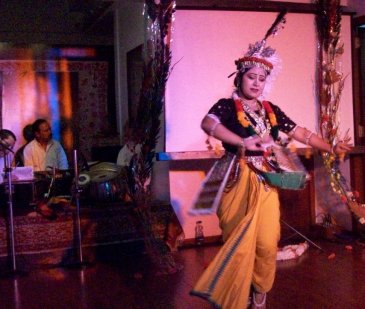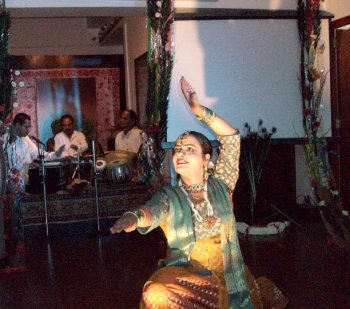
|   |

|   |
Tagore’s Bhanusinger Padavali by Anurekha Ghosh Text & pics: Nita Vidyarthi, Kolkata e-mail: nitavidyarthi@gmail.com May 16, 2012 Rabindranath Tagore was fascinated by the works of poets Joydeb and the Maithili verses and ideas of Vidyapati and Brijbhasa (the dialect of Brij). At the same time, he emulated the eighteenth century English boy-poet Chatterton and composed (and published) his first significant poetry in 1877. He adopted the pen name Bhanu Singha (he had been complimented with the name Bhanu by his sister-in-law Kadambari) and wrote a number of poems on the mysticism as found in Vaishnavism, embracing the Radha-Krishna theme. One of Tagore’s earliest compositions, the anthology (Padavali) of poems and songs Bhanusinger Padavali were written over a wide expanse of time and was not composed as a dance drama. Since they are all of the same theme, many composers and choreographers have presented it as a dance drama and undoubtedly it is one of Tagore’s most popular works because of its mellifluous songs and the lilting tunes, let alone the enchanting lyrics. Kathak dancer Anurekha Ghosh who has performed at home and abroad took up the challenge to present the popular dance drama, usually performed as a group composition, as a mono-act with a brief appearance of Malabi Chowdhury as Krishna. Presented at the Weavers Centre For the Arts, Kolkata, the mono-act began with the invocation of Joydev’s ‘Dasavatar’ by Anurekha followed by the symbolic import of Radha’s quest for Krishna that was inspired by the intoxicating sound of the flute. A disciple of Kathak exponent Nahid Siddiqui, Anurekha used the old form of Natwari Nritya style of the Kathak idiom. She began with “Gahana kusum kunja Majhe,” the song of spring and joy followed by the song of monsoon, “Sangana gaganey ghor ghanaghata” back to “Sunala sunala balika” and a series of other numbers concluding with “Sundari Radhey Awaye bani.”   Even though the sequence of the songs and poems in the original have not been maintained, the theme, the spirit, lyricism and the expressive content of Tagore have not been hampered. Anurekha is a competent dancer and her nritta and nritya statements incorporated in the execution was crisp and energetic, some quite distinctive and went very well with the many stanzas of poems, prose and rhythm. However the stamping of the foot was too powerful at times tarnishing the subtleties of the content. Some tranquility would have enhanced the offering. Her moves in the Natwari Nritya are not common and a pleasure to watch them adorned with some elegant tukhras but a few extended beyond the idiom. However, Anurekha managed well in the small performance space. A proper auditorium would have contributed to the spectators’ delight for numbers like “Hridayaka sadh mishawala hridaye” and the soul-stirring “E sakhi hamari dukher nahi oor, e bhara bhadar maha bhadar.” A duet with Malabi Chowdhury was enjoyable. Malabi is a well-trained Manipuri dancer and her Krishna nartan, especially the ‘kenduk khel’ was well executed and entertaining. The ambitious project is perhaps the first of its kind but nevertheless enjoyable. Even though one missed the sakhis, such an important part of the Radha-Krishna theme, especially in the Raas and of course in the beautiful song-dance sequence ”Aaju sakhi muhu muhu,” the attempt with choreographic mentoring by Anurekha’s guru, the famous singer Swagatalakshmi Dasgupta (Anurekha learns singing also), was interesting. The simple backdrop and the fine costume designed by Anurekha demonstrated her aesthetic skills and live music with vocal support by Shirshendu Mukherjee added to the appeal of the unusual Bhanusingher Padavali. However, too much red light and the excessive smoke from the smoke machine interfered with the aesthetics and joy of the presentation. Nita Vidyarthi is a critic of performing arts - dance, dance theatre and expressions - and a regular contributor to the Statesman (Kolkata) in dance, vocal music and theatre. Trained in Kathak, both the Jaipur and Lucknow gharanas, she was a disciple of the late Jaikumari, Ram Gopal Misra, Manjulika Roy Chowdhury and Gayatri Chatterjee. She had exposure to Bharatanatyam from Guru Maruthappa Pillai and Manipuri from Guru Bipin Singh and Kalavati Devi. A regular visitor to the festivals of UK and Europe, Nita is trained in vocal, semi-classical music and Rabindra Sangeet. A Science communicator, Ph.D. in Polymer Science, Commonwealth Scholar and a retired Professor of Chemistry, Nita devotes most of the time on dance and theatre writing. She also writes for The Hindu. |